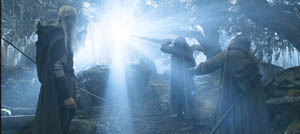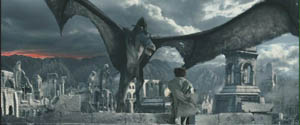|
Again, I'm reviewing the Extended Edition because it's definitely the better version, and the film benefits from the added material even more here than with the first film. So let's get started.  Having had my flesh nearly sheared off by the blast of awesomeness that was The Fellowship of the Ring, I had some seriously stoked hopes for the second film in the trilogy. Such being the case, it might be easily understandable that I wasn't quite so blown away with my first viewing of The Two Towers as I had been with Fellowship. There was also the fact that the second film wasn't nearly so close to the book as the first film had been-or actually, to be completely precise, the latter half of the second film wasn't as close to the book as the first one had been. The first half of the film version of The Two Towers was a damn good adaptation of the novel, chock-full of Tolkien's dialogue and memorable moments. But I, like many others, was initially blindsided by the rather numerous liberties taken with the second half, which invented several large events and substantially changed the motives of a few new characters. I felt somewhat disoriented by this initial viewing of a story I thought I knew already, and left the theater that night leaning towards confused. It was clearly a damn good movie, but all the wandering off of the original storyline had been distracting. However, when next I saw it, a full three days later, I was better prepared for the changes, and as such they made far less of an impact on my enjoyment. When at last the Extended Edition came out, it was clear that The Two Towers was probably as good a film as had been the first one, if not as faithful an adaptation. I could put aside my reservations and properly bask in its coolness. It's pretty clear that The Two Towers was the trickiest of the books to adapt; after all, it starts in the middle of the action and ends without the resolution having been reached. In fact, with the confrontation with Shelob moved to the third film (where it really did belong; the Aragorn and company half of the book covers nowhere near as much total time as the Frodo and Sam half did), Jackson and his co-writers had to deal with the rather tricky fact of our hero being basically unmolested for the entire duration of the film. This of course led to the skewing of the character of Faramir to the role of antagonist and the confrontation between Frodo and the Black Rider at Osgiliath, a city which neither Frodo nor Sam ever even saw in the novel. (Jackson acknowledges as much in the screenplay, which features Sam lamenting that "by all rights, we shouldn't even be here" near the close of the scene.) The depiction of Faramir as fallible (even if he succeeds in the end) was the change that drew the most fire from purists, and, honestly, the one that most took me aback, as well. In this area, the film benefited from the Extended Edition recut the most: we get to see more of the kind and honorable Faramir than we did in the theatrical cut, which makes the change to his character much more easily digestible. Other alterations seem less effectual, even allowing for the exigencies of book-to-film adaptations. Treebeard, the walking, talking tree-man, is shocked into acting against the villainous Saruman after seeing the destruction the wizard has inflicted upon his forest, even though he seems to be aware of this fact from the very start. There's no doubt that this was done to give Merry and Pippin something to do in terms of moving the action forward, since in the book they do essentially nothing but observe, but ultimately it doesn't quite ring true. The apparent death of Aragorn is the most befuddling. It doesn't detract from the story, but its purpose seems somewhat in doubt, since ultimately he shows back up alive and unhurt, having really achieved nothing in the meantime. These alterations differ from the changes to the Faramir story, whatever one might've felt about those, in that the scenes with Faramir are internally logical and airtight, whereas the Ent storyline became a wee bit confusing, and the digression with Aragorn seemed to just make an already long film longer. The arrival of a troop of elves at Helm's Deep also added a bit of story not in the book, but made sense in context (so long as one doesn't look at a Middle-Earth map and wonder how those elves could've gotten from Lothlorien to Helm's Deep before the orcs could get there from Isengard, about a tenth as far away) and served to help keep the elves from vanishing from the story altogether after their strong presence in the first film. The change no one seems to really ever notice is the whole role of the battle at Helm's Deep, which featured no civilian refugees in the novel and was not meant as a retreat, but a deliberate attempt to draw out and engage the enemy from a place of strength.  It hardly even seems necessary to mention what a fantastic effects achievement Weta Digital pulled off with Gollum; it pretty much goes without saying, though it's been said by nearly every reviewer under the sun. What I will comment on is the fabulous performance by Andy Serkis, without which all the digital mucking about on earth wouldn't have mattered. He creates a persona which is both sympathetic and repulsive, amusing and threatening, and since this broken, treacherous creature is possibly the most well-known character in all of The Lord of the Rings, his characterization was one of the most important to really nail. Thankfully, it truly pays off in an amazing way, and Jackson's methods of demonstrating Gollum's dual nature (which some reviewers somewhat bizarrely seem to think was invented for the films) went far beyond what I'd hoped for or expected. The extended cut of this film is even longer than the one for Fellowship, and probably does even more in the way of improving the story. There's a lot more to the Ent storyline, including the song of the Entwives and the massing of Fangorn forest at Helm's Deep, plus a surprise guest appearance by Old Man Willow, with Treebeard standing in for the still-absent Tom Bombadil. There's also a wealth of additional material about Faramir and his family, and familiar bits such as Merry and Pippin drinking the Ent-draught and finding Saruman's secret stash. And for the real Tolkien devotee, we get some really esoteric bits about the Ring of Barahir, just to remind us how much time the author spend ruminating on his imagined world. 
Jackson is truly a director who understands special effects work; it takes talent to make a morph interesting anymore, and King Theoden's release from the thrall of Saruman is undoubtedly the best-looking morph ever achieved. As overused as CGI tends to be these days, Jackson trumps them all with his digital Gollum and Ents, as well as the Uruk-Hai army, none of which are ever distractingly fakey like so many CG creatures tend to be. But the best effects work won't hold together a film that the audience doesn't feel involved with, and this is the real triumph of his Rings adaptations. If specific events differ from the print versions, the overall feel and thematic content remain the same. Theoden's pre-battle recitation of part of a poem about the legendary Eorl the Young or his graveside lament for his son aren't in the book, but they feel like they could've been. We may not hear Sam's wonderings on the life the fallen Harad soldier might've had back home, but Faramir speaks them aloud for us. Treebeard might seem more threatening on his first appearance than we're used to, but it's an excellently realized scene that nicely bypasses the very real potential for a big talking tree to come off as completely fruity. And if there wasn't much to the Aragorn/Arwen story in the timespan of the books, the film version affords us the chance to see a flash-forward to the time of Aragorn's death shown exactly as the appendices described it. All things considered, there's an awful lot of Tolkien in this film, differences or no. While many "devout believers" in the books may object to the changes, I have to wonder what professor Tolkien would've thought. While he may have been quite a curmudgeon and stickler for details, as an expert in ancient myths he would have been aware that all such myths have variants and alternate versions produced by different sources or competing cultures (the Arthur legend is so entrenched in English lore that many fail to realize that Camelot was initially set in France). Knowing that, I find myself contemplating whether he would have resisted any change, or simply accepted it as part of the evolutionary process that inevitably occurred with the kinds of ancient sagas he was seeking to revive. While of course we'll never know, I feel it's perfectly possible to enjoy both versions of the tale. When you boil it down to basics, the underlying themes are the same, and I think even the most stodgy defenders of the faith would have to concede that. But if not, it's hardly my problem. -review by Matt Murray
|
|
||||||||